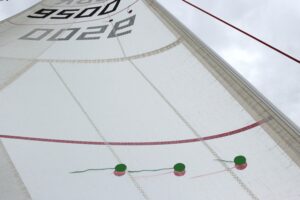In sailing, sail trim refers to adjusting the sails to the best angle relative to the wind. The goal is to position the sails to generate optimal lift through proper sail trim, allowing them to catch as much wind as possible without making the boat difficult to steer or become overpowered.
The jib is the smaller sail located at the front of the boat, ahead of the mast. Proper jib trim involves adjusting the sail’s angle and tension to optimize the boat’s performance in any given wind velocity. The mainsail, which is larger and attached to the mast and boom, plays an equally important role. Its trim also needs to be adjusted based on the wind direction, wind velocity, and the boat’s course.
Sail trim is one of the most important skills to master in sailing, but because wind direction is always changing, it can sometimes be difficult to judge whether your sails are trimmed properly.

Telltales are a helpful tool for accurately trimming sails. They are little strips of fabric, yarn, or ribbons attached to your sails, usually near the top and along the sides. As the wind flows across the sail, the telltales flutter or point in different directions.
Using telltales makes it easier for a sailor to gauge the wind’s behavior and adjust their sails accordingly, even though the wind itself is mostly invisible.
How Telltales Work
Telltales are typically placed near the luff of the sail, which is the forward edge closest to the direction that the wind is coming from. The luff runs from the top of the sail (the head) to the bottom front corner (the tack), and it’s the first part of the sail to encounter the wind.
-
-
- If the telltales are streaming straight back it means the wind is flowing evenly over the sail, and the sail is trimmed well.
-
-
-
- If the windward (closest to the direction from which the wind is coming) telltale is fluttering, either sheet in the jib toward the fluttering telltale or turn the boat away from the telltale (bear away) until it stops fluttering and flows smoothly.
-
-
-
- If the leeward (farthest away from the wind’s direction) telltale is fluttering, sheet out the sail toward the fluttering telltale or turn the boat away from the telltale (head up) until it stops fluttering and flows smoothly.
-
The lessons learned in Basic Keelboat will provide a strong foundation to help you build upon these sail trimming skills for the future. You can purchase Basic Keelboat through our website.
Support sailors on their journey. You can break down financial barriers and help sailors achieve their dreams. Donate to the US Sailing Scholarship Fund today.
